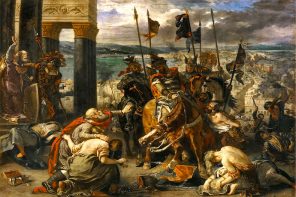Read all the posts in this series here. Doctor Who airs in the U.S. on BBC America on Saturdays at 9PM/8C (and though it’s by no means necessary, those interested in watching the first four seasons can find them streaming on Netflix) — ed.
James F. McGrath__________
Art and Religion: Seeing What Others Do Not
I still remember vividly when, many years ago, someone I knew was talking about how they had begun learning to paint, and how had they found to be true a tidbit of wisdom that another artist had passed on to them:
Painting is not primarily about learning to mix colors or make brush strokes, as important as those skills are. Above all else, becoming an artist involves learning to see the world differently. Before you can paint what you see, you need to see it in a way that can be translated into painting.
I found myself remembering this moment from my past as I watched this week’s episode of Doctor Who, “Vincent and the Doctor.” In it, the Doctor takes Amy to an art exhibit of Vincent Van Gogh’s paintings, and then, catching a glimpse of something “evil” peering through the window of a church in one of the paintings, they travel back to Vincent Van Gogh’s time to investigate.
There they find Van Gogh unappreciated in his time, and struggling with depression, but also able to see a dangerous alien creature that no one else—not even the Doctor—is able to. This obviously proves useful in eliminating the creature, but also seems to be intentionally symbolic of the artist’s stance: not only seeing the world differently, but as a result, seeing what others do not.
As I watched the scene near the end of the episode, in which the Doctor takes Vincent on a trip to that very same art exhibit, and gives him an opportunity to eavesdrop on the museum guide’s praise of Van Gogh’s art from the standpoint of our time, I recalled another artist’s famous saying (in this case, a composer, but the principle seems to apply equally well to other fine arts). After his fifth symphony was met with an unappreciative response from critics, Gustav Mahler expressed the desire to be able to conduct its premiere fifty years after his death. Perhaps precisely because of their distinctiveness of vision, artists are often unappreciated in their time, but seem to just as often be valued later on. It is as though they are literally “ahead of their time” in a manner that even a time lord might not be able to make sense of.
While many seem unable to conceive of religion and science as anything other than competitors, it is helpful to reflect on the possibility that religion is far more like art than like science. Like the arts, religion involves seeing the world in a distinctive way. And as in the arts, people of profound religious vision are often rejected by their contemporaries and yet appreciated greatly by later generations.
Science and art are not in conflict. A scientific analysis of the paint Van Gogh used, their chemical composition and reflective properties, is entirely possible. And it is a completely different perspective than that which might ask why we find his art compelling, while the subjective experience of seeing and responding to his art seems to be something else yet again. There are different levels of reality, as it were, different ways of looking at the same phenomenon, and these are frequently neither incompatible with one another nor competing to provide answers the same sorts of questions.
Perhaps it is time to stop asking whether religion or science offers a better explanation of natural phenomena, and instead ask, much as we might of art, whether we find a certain religious vision compelling—and if so, why.
Religion (as I see it—and of course that’s the point!) differs from science inasmuch as it isn’t primarily about describing the world as it is (although it should take our best understanding of the natural world into account), but about depicting the world as it could be, and transforming it into that better vision of reality. And of course, when religion takes a harmful view of the future, it can often contribute to bringing about a minor apocalypse.
This episode ended with the Doctor and Amy not having managed to prevent Van Gogh’s suicide, in spite of the encouragement they offered him. Depression and mental illness are at least as common among artists and in religious communities as in society in general, and perhaps more so. Perhaps having a brain that works in an unusual way facilitates seeing the world differently than others—for better or worse, and perhaps sometimes for both.
In some religious communities, depression is often misdiagnosed as demon possession, or struggled with alone in silence as a spiritual condition. We have witnessed in the news numerous tragedies that have resulted from this state of affairs. And so it was delightful that the episode ended with suggestions on where to go for help with real-life mental health issues.
Religion may be a form of artistic vision of the world. But not every vision should be embraced, nor should all enthusiasm be diagnosed as spiritual fervor rather than a lack of maturity or perhaps even an indication of an even more serious psychological problem. But even art the perspective of which we reject can speak to us and challenge us to find a vision of our own.
And so I encourage you to take the “Van Gogh Doctor Who challenge,” and try to take a small step in the direction of seeing things differently, and of noticing what others do not. Because that’s equally important in the realms of science, art, and religion.
Gabriel Mckee__________
Vincent and the Doctor
Earlier in the season, we discussed the ontological constraints placed on time travelers. When he travels into the past, the Doctor walks a fine, thin line between benevolent intervention and disastrous interference. When he crosses that line—as in the first season episode “Father’s Day,” where Rose prevents her father from dying in a car accident—the consequences are generally disastrous. In other cases, it seems, no amount of well-intentioned action can change an unfortunate outcome. Some events are fixed, and no time traveler can determine the proper amount or type of meddling to change them.
That’s the case in “Vincent and the Doctor.” The primary reason the Doctor and Amy travel back to 1890 is to locate and defeat the frightening creature they see in one of Vincent van Gogh’s paintings. But once they arrive in the artists’ era, they can’t help but interfere—telling van Gogh, the subject of much mockery and derision in his town, that he is to be remembered as one of the greatest painters of all time. It doesn’t stop there—when she discovers that he hasn’t yet painted “Sunflowers” (a minor historical inaccuracy), Amy not-so-subtly arranges dozens of them outside his home. At the conclusion of the episode, the Doctor goes perhaps further than he’s ever gone before into “interfering” territory, bringing van Gogh for a trip in the TARDIS to see his work on display in the Musée d’Orsay.
The artist is (understandably) awestruck—what greater contrast could there be to his day-to-day life, where he is perceived as an outcast, a drunk, a madman, and, worst of all, untalented? The Doctor and Amy hope that this visit to the future will rescue Vincent from despair and stop him from committing suicide a few months after their visit, but they fail—van Gogh dies as scheduled (after completing a painting of some sunflowers for Amy, of course). Was this one of those moments in history—like the demise of the Mars colony in last year’s “Waters of Mars”—that is unchangeable, a fixed point that no amount of meddling can alter? Or, more bleakly—did the Doctor and Amy actually create the despair that led him to suicide? Was the disconnect between his bleak life and his glorious afterlife too much for him to bear? Did he begin to wonder if the mysterious time travelers were simply another elaborate delusion, a further stage in his madness?
“Vincent and the Doctor” doesn’t really explore those possibilities, but I couldn’t help but wonder at their omission. The writers don’t pass judgment on the Doctor’s actions in this episode, but I see a tension in this story over van Gogh’s suicide: it seems to have been either a fated event (in which case the mysterious forces of time were set against the Doctor’s goals), or an unintended effect of the time travelers’ interference (in which case Vincent is a victim of the Doctor’s hubris). In either case, van Gogh is collateral damage in a battle that’s in the background of all of Doctor Who—the battle between the Doctor and… what? Time? The universe? Fate? Chaos? God? The Doctor has always been a rebel—he always pushes the “protest” button. Most of the time that rebelliousness works out for the best, and he becomes (as I described him earlier this season) an anarchist messiah. But when his attempts at salvation fail, the innocent can suffer.
There was one thing about this episode that made me a bit uncomfortable. “Vincent and the Doctor” fictionalizes the real-life suffering of its subject, coopting the real despair of a real person into a narrative about invisible space demons and time travelers. This certainly isn’t the first time the Doctor has set foot in real history, nor is it the last. But for all the episode’s sympathy with van Gogh’s suffering, I couldn’t help but think that it went more than a few steps into romanticizing it as well. There’s something a bit too flip about saying that the demons that tormented van Gogh may have been giant, invisible aliens that wanted to eat his neighbors. This episode was all about perception, and there’s certainly something to be said for James’ “van Gogh Doctor Who challenge.” But there’s also a certain irony in the show’s suggestion that van Gogh’s hallucinations were real. Surely the world caught up to his way of viewing the world as expressed in his art. But the nature in which this episode depicts his mental state could serve to undermine the its intended sympathetic portrayal of mental illness. This is another fine line on which the Doctor occasionally travels, and in this instance, I don’t think he traveled it carefully enough.




